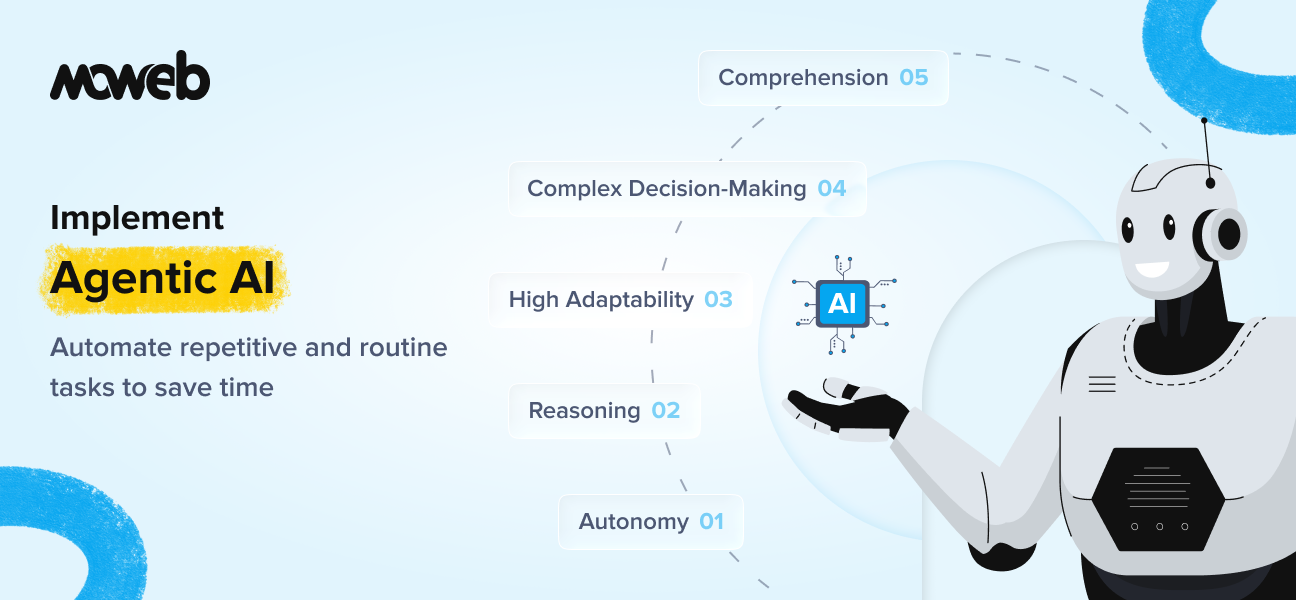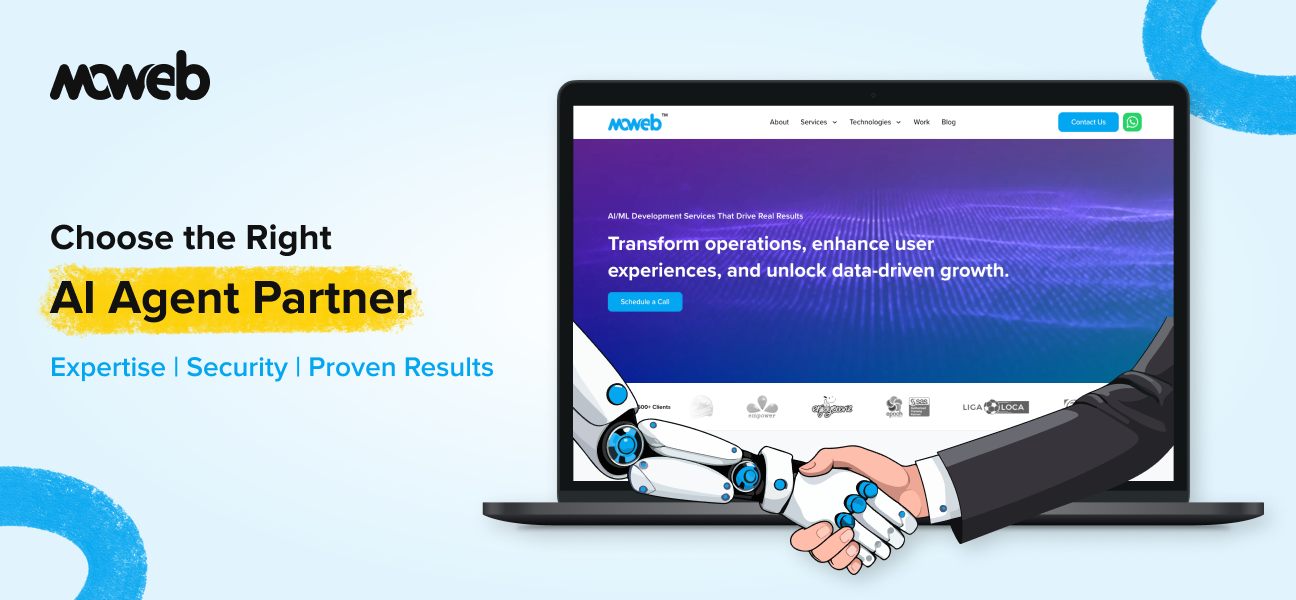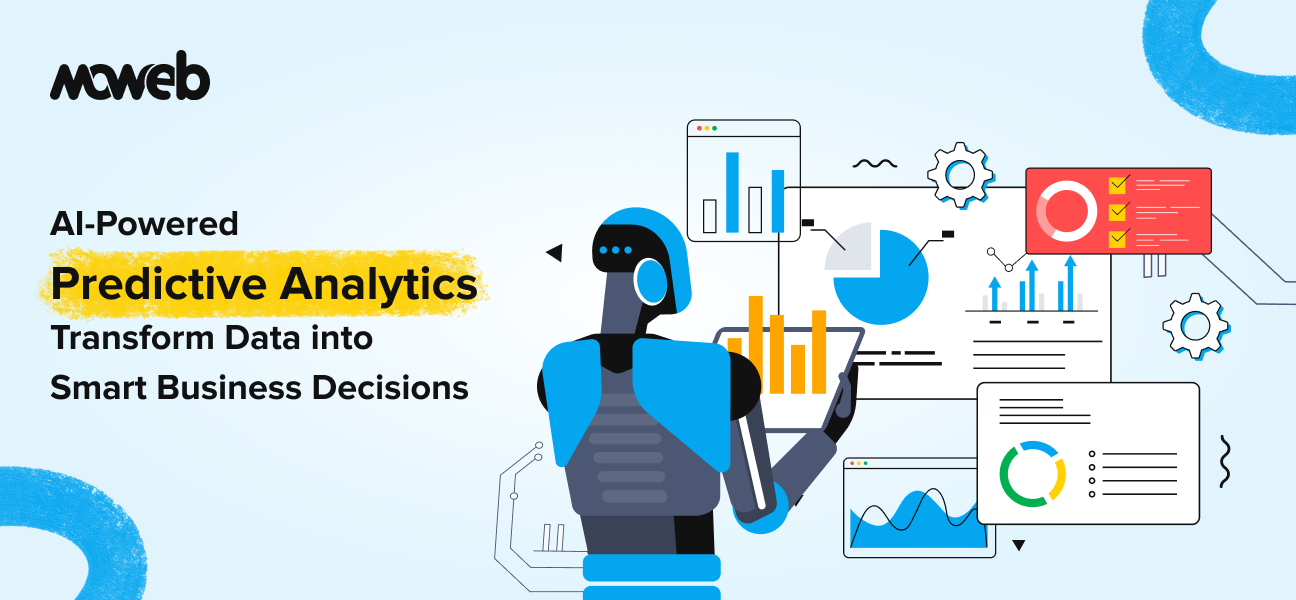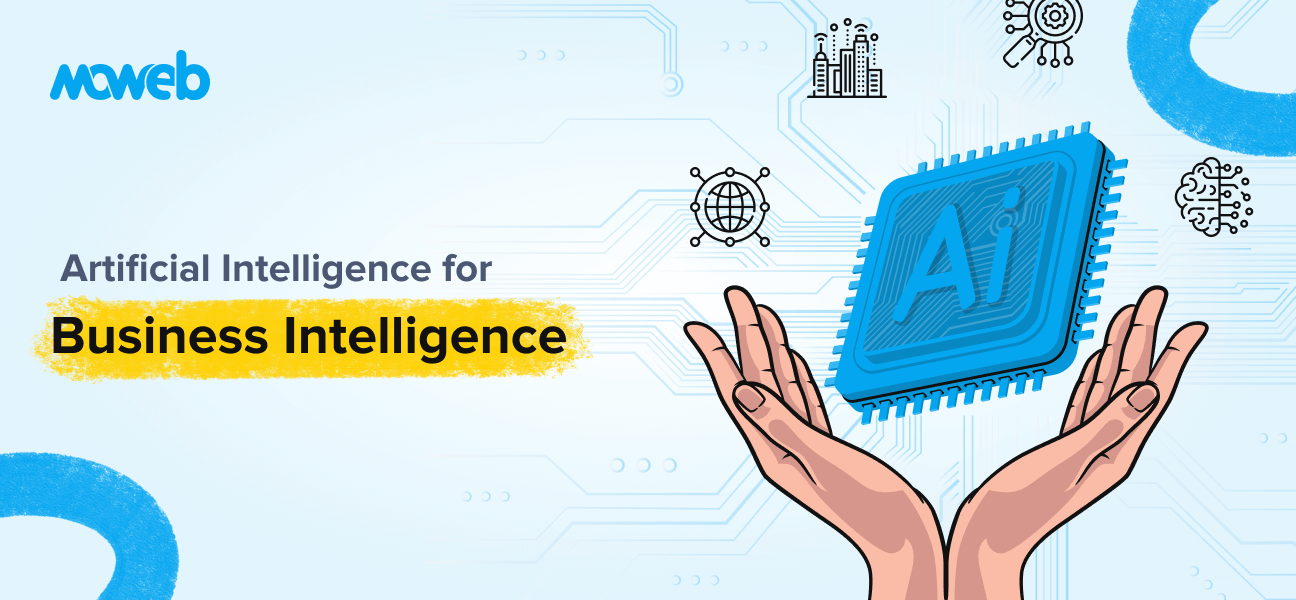
How would you feel if you spot market trends before they take off, outsmart your competitors with better insights, and take business decisions more confidently? Welcome to an era where Artificial Intelligence in business is doing the guesswork and turning complexities into clarity.
And the fusion of AI and Business Intelligence is altogether a total shift, or rather an earthquake in the market. Earlier, BI offered static reports and slow-moving analytics handled by specialists. But now, AI for Business Intelligence is putting lightning-fast, predictive, and self-serve insights. The global AI market for business intelligence is projected to hit $244 billion by 2025, with some industry forecasts predicting growth to $826 billion by 2030.
But if you are wondering, why does this matter now? Because today’s market has no room for hesitation and indecision. Organizations that use AI-powered BI move faster, seize new opportunities, and automate what others still analyze manually. So, the question isn’t whether your business will adopt AI in business intelligence; it is whether you’ll take the lead or want to be left behind. In this guide, we will help you discover exactly how AI is reshaping business intelligence and share some incredible benefits and tips for implementation.
The Evolution of Business Intelligence with AI
Traditional BI relied on descriptive analytics and static reports describing “what happened.” Analysis was often manual and limited to predefined queries, handled by specialized BI teams. On the contrary, AI-driven business intelligence:
- Applies machine learning, natural language processing, and automation to generate insights dynamically.
- Enables predictive and prescriptive analysis, uncovering not just what happened but why and what’s likely next.
- Makes BI accessible to all users, not just technical analysts, via self-service tools and conversational interfaces.
With that said, you can clearly see that traditional batch processing and manual data queries are giving way to real-time, automated analytics powered by AI-driven pattern recognition and forecasting.
The Impact of AI on Business Intelligence
AI for Business Intelligence is pushing the boundaries of what organizations can achieve with data. Here’s how artificial intelligence in business is transforming BI and why you can’t afford to stick with traditional analytics.
Automation, Predictive Analytics, and Real-Time Insights
The days of waiting for batch reports are over. 83% of companies list AI as a top business priority in 2025, and 77% have already integrated some form of AI in their business analysis services.
AI-powered business intelligence automates everything from data collection to analysis. It is enabling predictive analytics in business that anticipates trends, flags risks, and pinpoints new opportunities before competitors see them. This shift allows organizations to respond to changes in real time, accelerate business analysis services, and fuel smart decision-making at every level.
Related Post: AI in Manufacturing: Top 10 Use Cases & Future Trends 2025
Traditional BI vs. AI-Driven BI: The Transformation
| Feature | Traditional BI | AI-Powered BI |
| Data Processing | Batch/manual | Real-time, automated |
| Insights | Descriptive (“what happened”) | Predictive & prescriptive (“what’s next?”) |
| User Accessibility | Primarily technical users | Accessible to all via NLP |
| Adaptability | Static dashboards | Dynamic, self-learning |
| Scale | Limited | Highly scalable |
| Decision Support | Slower, manual | Instant, actionable recommendations |
AI for Business Intelligence means your data isn’t just explaining the past. It’s recommending actions for the future. This leap ensures that even non-technical employees can explore automated business analytics and make informed decisions.
Empowering Self-Service Analytics
AI removes traditional roadblocks to analytics. Modern platforms enable users to ask questions in everyday language and get instant answers. And guess what? There is no need for specialized BI knowledge.
Enhancing Data Narratives and Visualization
AI also creates dynamic stories from your data. With features like automatic data storytelling and adaptive dashboards, complex trends are visualized and explained clearly, giving leaders actionable intelligence instantly.
Augmented Intelligence & Operational Excellence
By combining machine learning in data analysis with human expertise, AI for business is supercharging operational efficiency. Routine data plumbing is delegated to smart algorithms, letting talent focus on strategic action. The result? Greater business agility, fewer errors, and smarter, faster decisions through business intelligence automation.
Benefits of AI in Business Intelligence
AI for Business Intelligence empowers organizations with faster, more accurate data analysis, transforming AI for real-time decision-making, predictive analytics, and business intelligence automation. By democratizing analytics access and reducing human error, AI delivers benefits across all business functions, driving agility and sustainable competitive advantage.
- Increased Data Accessibility and Democratization: AI-powered BI removes barriers, making data analysis accessible to non-technical users via intuitive dashboards and natural language queries.
- Enhanced Forecasting Accuracy and Predictive Capabilities: AI’s ability to learn from big data sets leads to more accurate forecasting, supporting everything from inventory planning to financial projections.
- Faster Data Processing and Real-Time Analysis: AI for small businesses enables ultra-fast processing, allowing instant responses to business changes and letting leaders act in real time.
- Significant Reduction in Human Error: By automating repetitive tasks, AI virtually eliminates manual errors and inconsistencies, boosting efficiency and trust.
- Enhanced Decision-Making Across Departments: Departments like marketing, finance, and operations benefit from tailored recommendations and scenario analysis via automated business analytics.
CTA: Unlock the transformative power of AI for Business Intelligence with Moweb. Schedule a free consultation or demo to discover actionable insights for your organization.


Unlock the Transformative Power of AI with Moweb
Schedule a free consultation or demo to discover actionable insights for your organization.
Top Practical Use Cases of AI in Business Intelligence
AI for Business Intelligence is the driving force behind smarter, faster, and more personalized AI for real-time decision-making. Let’s dive into the most impactful use cases, each delivering real value with powerful technology at its core.
Predictive Analytics: Seeing Tomorrow, Today
AI for Business Intelligence harnesses predictive analytics to transform vast historical data into actionable forecasts. From demand planning to risk assessment, businesses can now anticipate changes and optimize strategies before competitors react. Machine learning models reveal patterns human eyes would miss, reducing uncertainty and driving growth, making predictive analytics in business truly indispensable.
Natural Language Processing (NLP): Analytics Everyone Can Use
With NLP supercharging artificial intelligence in business, anyone can interact with data using simple, everyday language. Ask questions, generate reports, and uncover insights without needing BI expertise. From sentiment analysis on social media to instant customer feedback summaries, NLP democratizes analytics, putting AI-powered data insights at everyone’s fingertips.
Automated Reporting & Dashboards: Turn Data into Action, Instantly
Forget manual number crunching. Automated reporting combined with AI delivers dashboards that refresh themselves, detect trends, and highlight anomalies in real time. Teams get instant, up-to-the-minute metrics and natural language reports, focusing on rapid response and better outcomes instead of endless spreadsheet work. Real-time, AI-driven dashboards mean smarter business analysis services and quicker decision-making.
Marketing Campaign Analysis: Smarter, Personalized, Real-Time Wins
AI for small businesses is revolutionizing marketing campaign analysis by enabling hyper-targeted strategies, dynamic content customization, and instant performance tracking. Marketers use machine learning to fine-tune segmentation, improve lead scoring, and predict campaign outcomes, ensuring every dollar is spent wisely. Real-time insights allow fast pivots and deeper customer engagement, leveling the playing field for enterprises and AI for small businesses.
Fraud Detection & Risk Analytics: Stay One Step Ahead
AI-powered fraud detection and risk analytics protect companies by analyzing countless transactions in milliseconds, spotting suspicious activity or hidden risks far faster than any human could. Machine learning adapts to new fraud patterns, while predictive analytics ensures threats are stopped before they cause damage, which is vital for industries from finance to e-commerce to healthcare.
Customer Segmentation & Personalization: Treat Every Customer Uniquely
AI-driven customer segmentation transforms generic marketing into hyper-personalized experiences. By analyzing behavior, transaction history, and even real-time interactions, AI can predict preferences, suggest targeted offers, and update segments on the fly. This powerful personalization boosts conversion rates, brand loyalty, and overall customer satisfaction, delivering major wins for businesses of any size.
How to Implement AI in Business Intelligence (Step-by-Step Guide)
Implementing AI in Business Intelligence requires a strategic, phased approach that aligns business goals with the right data, tools, and training. Here is a step-by-step guide:
Step 1: Define Business Goals and KPIs
Implementing AI in Business Intelligence begins with clear objectives tailored to your organization’s needs. Set measurable KPIs like reducing report turnaround time or boosting forecast accuracy to ensure your AI strategy delivers real business value.
Step 2: Audit Current Data and Infrastructure
Implementing AI in Business Intelligence requires a thorough evaluation of your existing data landscape. Examine your data sources, formats, and technology stack to make sure your infrastructure supports seamless AI integration.
Step 3: Choose the right AI + BI tools & Platforms
Implementing AI in Business Intelligence means selecting the right platforms for your goals and scale. Analyze leading solutions such as Power BI, Tableau, Qlik, ThoughtSpot, and Looker to match features like machine learning, NLP, and automation to your business needs.
Step 4: Ensure Data Quality and Integration
Implementing AI in Business Intelligence hinges on high-quality, unified data. Deploy strong ETL processes and data governance to clean, standardize, and consolidate data across all business lines.
Step 5: Train Teams on AI-driven Analytics
Implementing AI in Business Intelligence is only effective when teams know how to use it. Invest in hands-on training, workshops, and continuous learning to empower staff with AI-powered analytics and business analysis services.
Step 6: Start with Pilot Projects
Implementing AI in Business Intelligence works best by testing on a small scale first. Roll out pilot projects in key departments, gather results, and use feedback to refine your larger rollout plan.
Step 7: Measure, Optimise and Scale
Implementing AI in Business Intelligence ensures value through ongoing measurement and improvement. Continuously track KPIs, enhance processes, and scale successful AI initiatives across the organization for enterprise-wide impact.
Key Technologies Powering AI for Business Intelligence
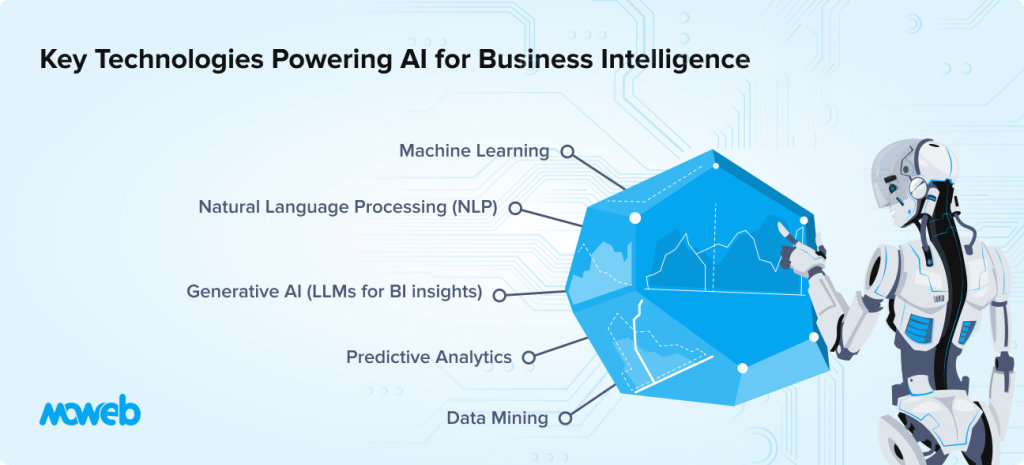
Key technologies powering AI for Business Intelligence include:
- Machine Learning: Core to pattern recognition, forecasting, and personalized insights (machine learning development).
- Natural Language Processing (NLP): Powers chatbots, voice assistants, and self-service analytics.
- Predictive Analytics: Delivers future-focused insights for business growth.
- Data Mining: Extracts valuable patterns from massive data sets.
- Generative AI (LLMs for BI insights): Automates report writing and interactive data narratives for business users.
Challenges in AI-Powered BI & How to Overcome Them
While AI-powered Business Intelligence offers immense potential, organizations must navigate challenges like data quality issues, high implementation costs, and adoption resistance. Overcoming these hurdles with strategic planning, training, and ethical AI practices is crucial to discover the full power of AI for small businesses.
Data Quality and Integration
Poor data quality and fragmented sources undermine the effectiveness of AI for Business Intelligence, leading to inaccurate insights and wasted resources. Overcoming this requires robust data governance, standardized cleaning processes, and smooth integration strategies to unify and validate information across platforms.
High Implementation Cost
The expense of deploying artificial intelligence in business can be too much for organizations. Mitigate costs by prioritizing high-ROI pilot projects, leveraging scalable cloud-based solutions, and partnering with an experienced AI development company.
Change Management & Adoption Resistance
Transitioning to AI-powered BI often faces pushback from teams wary of new technology or job disruption. Success lies in proactive change management, such as clearly communicating benefits, providing extensive training, and fostering a culture that celebrates data-driven decision-making.
Security & Ethical Concerns
With sensitive data and powerful analytics, AI for business intelligence introduces risks around privacy breaches and unethical data use. You can address these issues by enforcing strong encryption, implementing access controls, conducting compliance checks, and maintaining transparent AI practices.
Bias in AI Models and Mitigation Strategies
AI models are only as fair as the data and assumptions behind them. If unchecked, they can increase biases and lead to skewed results. Regularly audit algorithms, diversify training datasets, and implement bias detection tools to ensure fair, responsible AI-powered business analysis.
Related Post: How AI Is Transforming Supply Chain Management
Future of AI in Business Intelligence
The future of AI in Business Intelligence is set to transform AI for real-time decision-making with hyperautomation, conversational AI copilots, and predictive storytelling, creating smarter, faster, and more intuitive analytics experiences. As these innovations unfold, businesses will unlock unprecedented agility and insight to stay ahead in competitive markets.
Hyperautomation in BI Dashboards
Hyperautomation is set to revolutionize AI for Business Intelligence, automating every step from data preparation to actionable insights. This trend will enable businesses to deploy fully autonomous analytic pipelines, delivering instant answers and freeing up human talent for strategic analysis.
Conversational BI with AI Copilots
Conversational interfaces are transforming the user experience, as AI copilots let users interact with business data using voice or chat. These copilots instantly generate reports, answer complex queries, and create visualizations making advanced analytics accessible to everyone.
Real-Time Decision Engines
Real-time decision engines automatically process new data and can trigger immediate business actions, such as adjusting supply chains or responding to market changes. This ensures organizations stay agile, responsive, and a step ahead of the rest.
Predictive Storytelling
Predictive storytelling uses AI to transform numbers into narratives, making complex trends and forecasts easy to understand. Organizations benefit from clear, data-driven stories that highlight opportunities and risks for confident decision-making.
AI-powered Augmented Analytics
Combining machine learning, automation, and dynamic visualization, AI-powered augmented analytics uncovers deeper insights than ever before. This empowers organizations with proactive recommendations and advanced business intelligence automation for smarter strategizing.
Increased Adoption of Generative AI
Generative AI and large language models (LLMs) are reinventing how organizations create dashboards, reports, and actionable recommendations. These powerful engines synthesize diverse data sources, automate narrative generation, and offer personalized insights at scale.
Conclusion
AI for Business Intelligence has fundamentally transformed how organizations harness data, shifting from static reports to dynamic, real-time, and predictive insights. This evolution empowers businesses with enhanced forecasting accuracy, smarter decision-making, and operational efficiency across all departments.
The integration of artificial intelligence in business unlocks unprecedented data accessibility and democratizes analytics, enabling companies to stay competitive in fast-paced markets. Embracing AI for Business Intelligence is no longer optional but essential for growth and innovation.
Take the next step, schedule a free consultation or demo with Moweb today, and unlock the potential of AI-powered data insights for your business.
FAQs
What’s the future of AI in the business intelligence landscape?
AI for Business Intelligence is driving a transformation toward real-time analytics, business intelligence automation, and intelligent decision support, making BI more predictive and interactive every year. Businesses embracing artificial intelligence in business will gain agile insights and a competitive edge as AI and machine learning reshape how organizations analyze and act on data.
How to choose between traditional BI and AI-powered BI?
Opt for AI-powered Business Intelligence if you need instant, predictive insights and self-service analytics that empower all users; traditional BI suits those focused on static or historical reporting. AI for small business unlocks scalable, automated workflows and democratized analytics, which is key to thriving in today’s data-driven environment.
What are the best tools for AI-powered business intelligence?
Leading AI for Business Intelligence platforms include Power BI with Copilot, Tableau with Einstein/GPT, Qlik Sense, Looker, ThoughtSpot, and Sisense, all offering advanced generative AI and natural language capabilities. These tools enable automated reporting, predictive analytics in business, and intuitive data access for every organization.
Is AI replacing traditional business intelligence?
AI is not replacing traditional BI but enhancing it. AI for Business Intelligence augments human analysts with faster, real-time, and predictive insights, turning static reporting into proactive decision-making. Artificial intelligence development services are advancing BI platforms, enabling greater accuracy, automation, and strategic value.
What industries benefit the most from AI in BI?
Industries like finance, manufacturing, logistics, e-commerce, healthcare, and retail see the greatest impact from AI for Business Intelligence, leveraging machine learning in data analysis to optimize processes, detect fraud, and personalize offerings. Both enterprise and AI for small business users are achieving operational excellence and data-driven growth.
How secure is AI-powered business intelligence?
AI-powered BI platforms utilize robust security protocols, including encryption, access controls, real-time monitoring, and AI-driven threat detection, to safeguard sensitive insights and ensure compliance. Working with a trusted AI development company or enterprise software development company ensures your business analysis services meet the highest security standards.
Found this post insightful? Don’t forget to share it with your network!



